
1. Testing for the change in pH as CO2 is injected
How do we know how much CO2 to inject into the planted tank? As gaseous CO2 is dissolved in water, a small portion of it turns into carbonic acid, lowering the acidity of the water (which will cause the pH level to drop). CO2 levels can thus be gauged by comparing the pH of the tank’s water before injection starts and during CO2 injection, during which the pH will drop steadily as CO2 levels build up in the water till it reaches equilibrium – when your injection rate of CO2 equals to the rate of off gassing of CO2.

Although the above chart is helpful we have made a calculator for you that is easier to use.
This is done by by exploiting the pH:KH relationship – for a known KH value, the pH drops at a predictable rate for a certain amount of CO2 injected into the tank.
You need two values – the pH before CO2 injection (which assumes gaseous equilibrium with atmosphere, i.e. no significant CO2 in the water), and the pH value of the tank’s water when CO2 has reached saturation point. To reach this point may take from 1 to more than 3 hours of CO2 injection depending on the injection rate and gaseous exchange mechanism of the individual tank.
A generally good range to target is a 1 point pH change. So, for example, if your tank’s pH starts at 7.5, you would target a pH of 6.5 for when CO2 hits saturation during CO2 injection. This would give you about 30+ppm of CO2 for tanks where the KH value is between 1 to 10 degrees KH.
TLDR – if your tank’s KH is between 1 to 10 degrees, aim for a 1 point pH drop difference between no CO2 injection and CO2 injection at saturation point.
You should be present to observe planted tank livestock for distress anytime CO2 is tuned up. CO2 build-up can take hours, so plan accordingly.
2. Drop-checkers
Many hobbyists like using drop checkers, but they are not a reliable method of determining CO2 levels. Drop checkers depend on gaseous exchange at the site where the drop checker is located – this, in turn, depends on the water flow and position of the drop checker, quality of testing reagents, and color interpretation.
‘Green’ doesn’t mean that one has good levels of CO2 in the tank. It just means that the drop checker is receiving some CO2 at that position. This result can also be poorly skewed if it is in a position to capture CO2 bubbles that would otherwise be off gassed through surface water.
Because of all these reasons, the error ratio for drop checkers is too wide to be helpful in cases where it matters the most – when folks are facing problems or trying to grow more difficult plants that require optimized levels. Because most easier plants can grow in a wide range – most tanks do ok with low levels of CO2, but this does not mean that the device is working effectively. The actual test (and often where weakness is exposed) is when a hobbyist tries to grow more challenging varieties of plants that require high levels of CO2.
3. Gauging CO2 levels by observing plant growth form
For planted tanks, we should generally aim to inject as much CO2 as the most CO2 sensitive plant we are currently growing requires. Plant growth form varies widely for species that need high CO2 levels to grow well. Thus, observing plant growth form tells us the most accurate feedback on whether the plant is getting enough CO2. The obvious downside of this method is that interpreting plant growth form takes experience that newer aquarists will not be endowed with.
A common plant that is a good test for CO2 levels is HC (dwarf baby tears). It is an undemanding plant as long as it has access to rich CO2 levels – which allows us to quickly isolate changes in CO2 levels as the leading cause of its growth speed & form. There are comparisons of HC grown under various CO2 levels on the plant page. Other picky plants that require good CO2 levels are Blood vomit and the red Eriocaulon quinquangulare.
This skill should be something that every planted tank enthusiast should aspire to build up to in time by observing their plant growth forms over different CO2/dosing regimes. In the long run, interpreting plant growth form is a tremendous convenience as you can gauge CO2 and nutrient levels in a tank without needing test kits. This allows you to monitor your tank daily without needing more troublesome equipment or tests. It also allows you to guess the methods by which other folk’s tanks are run – just by looking at the state of their plants.
Plant reactions to CO2 levels are usually not immediate; what we are looking for is new growth over a week or two
This is especially true for new setups with other instabilities that can affect plant growth forms; these need to be resolved before any analysis can be done. For this reason, I recommend that new aquarists pre-cycle their tank before planting them. It takes a couple more weeks but reduces problems, especially for beginners.
CO2 affects general health/growth speed and vigor in aquatic plants as it makes up about 50% of plant dry mass.
A lack of it manifests in many ways:
- Thin stem, leaves, though adequate fertilization/light is given.
- Bare lower stems, old leaves fading quickly only leaving healthy top leaves; this is often coupled with algae issues.
- Vertical growth in carpeting plants, rather than horizontal creeping.
- Exaggerated stem elongation combined with bare lower leaves; often a sign of both poor CO2 & poor O2 together.
- New growth curled & stunted.
- Progressively more minor & smaller new leaves- this is one of the most vital signs of CO2 deficiency.
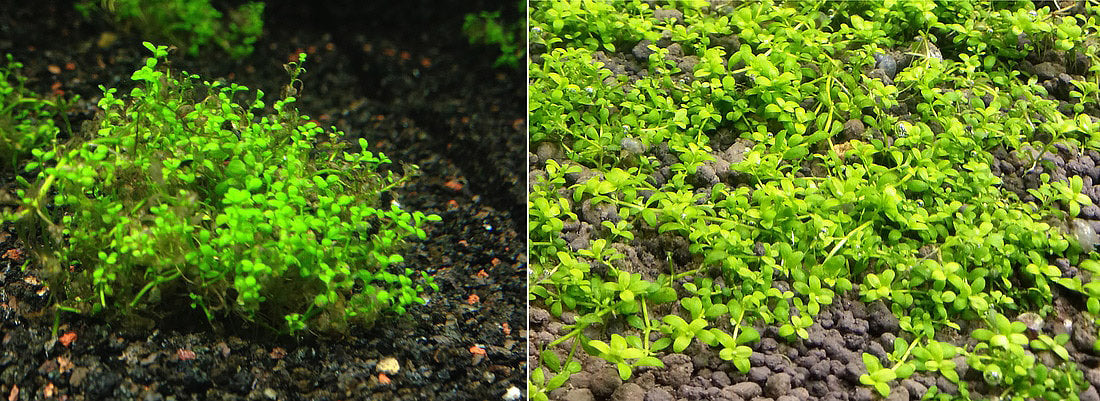
HC is one of the best indicator plants for CO2 levels. At sub-optimal levels, the plant grows spindly and vertically with small leaves. With good levels of CO2, it exhibits a robust creeping form with good sized leaves. HC is a perfect test for CO2 because it is not very demanding about fertilization. It can be grown in every tank as a CO2 gauge; it’s small and nondescript enough to have in any tank’s foreground.
Rotala Rotundifolia
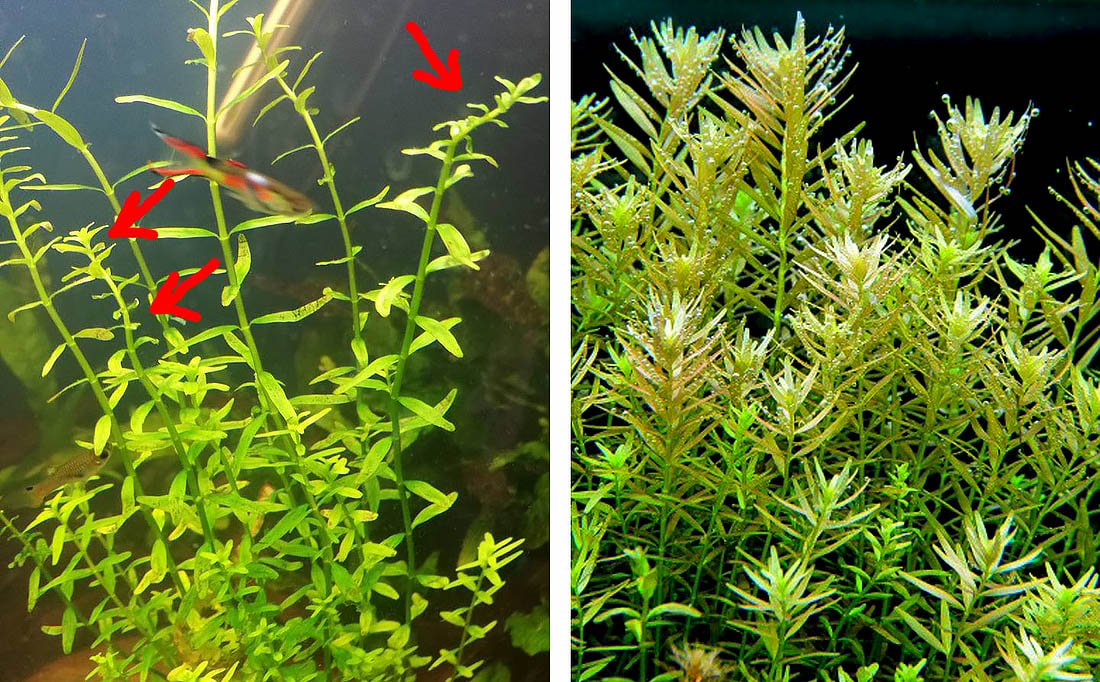
The pic on the left shows several signs of classic CO2 issues in Rotala rotundifolia.
Elongated internodes, uneven growth patterns, and increasingly smaller leaves in new growth. Long internodes often hint at the combination of poor CO2/O2; more is covered under the gaseous exchange section. The picture on the right shows the same species under better conditions.
Ludwigia sp. Red
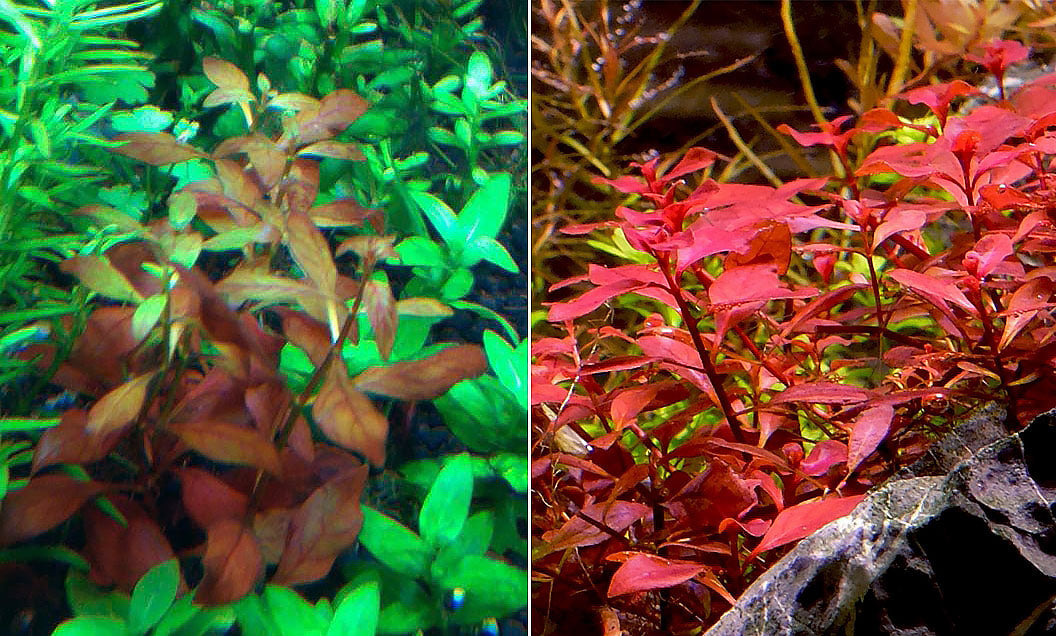
Note the thinning stem and progressively smaller leaf forms on the left picture of Ludwigia sp. Red. Overall, the leaf form is also smaller.
In the left pic, older growth looks distinctively redder and more fully formed. This hints that the current conditions are problematic, while the plant grew better in the past.
Alternanthera reineckii “AR”

On the left, elongated, loose growth form of Alternanthera reineckii, common in many non CO2-injected planted tanks vs more deeply colored denser form under good CO2/lighting.
Observe the difference in leaf size & coloration. The overall growth form of the plant is also denser, with good CO2 access. CO2 alone will not produce good coloration; it works hand in hand with lighting and good fertilization.
Monte Carlo
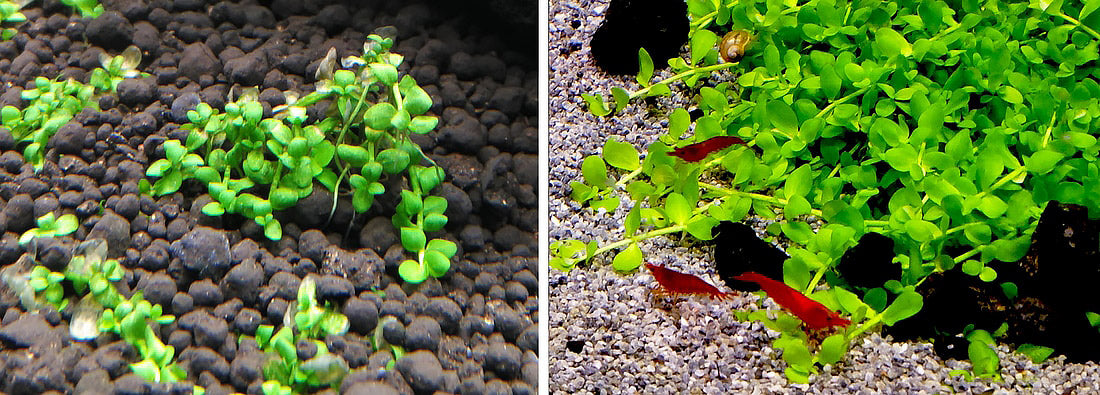
Micranthemum monte carlo is one of the easiest foreground plants. Many tanks without CO2 injection can grow it with success.
However, it exhibits a more diminutive growth form (left) than CO2-enriched tanks (right). Note the much smaller sized leaves. Less robust growth also makes it more vulnerable to algae.
Mosses / Riccardia
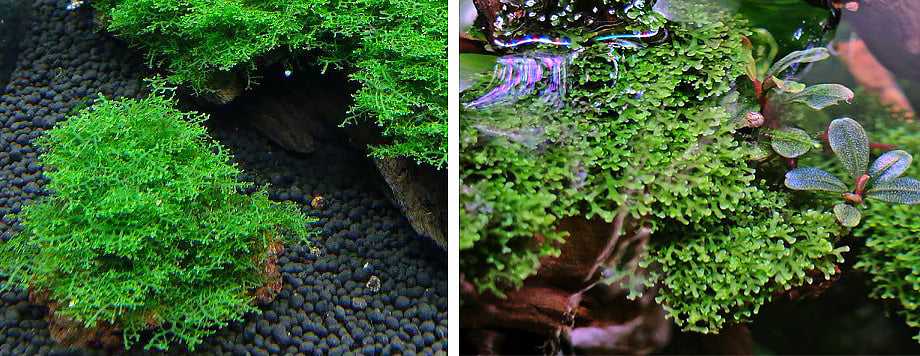
Most mosses can survive low CO2 levels and are suitable for non CO2 injected tanks. Here Riccardia/Mini-pelia shows a fuller, more compact growth form in a high CO2 environment on the right. It also feels stiffer to the touch.
Read this section for detailed plant guides on HC, Monte Carlo, “AR,” and more. (Coming Soon)
Off-gassing / Gaseous Exchange
Off-gassing/gaseous exchange occurs whenever there is contact time between the water surface and air. It brings tank O2 & CO2 levels closer to atmospheric concentrations. In our planted tanks, we need a certain amount of this. This seems counter-intuitive at first, but it makes tuning CO2 levels higher much easier. As your CO2 injection reaches saturation point – because the tank is an enclosed system, your injection rate will eventually equal the rate of off gassing of CO2. If you want to inject at a higher rate – there needs to be a sufficient off gassing mechanism to prevent a lethal build-up. To have a high, non-lethal saturation rate of CO2 in the tank, ironically, we need a good off-gassing mechanism and high CO2 injection rates. To read in-depth about the physics of why this is so, head to this section.
To have good gaseous exchange isn’t that difficult. Firstly, have a decent amount of surface agitation and clean water surface. (surface skimmers, sumps). Secondly, have a good turn over of the top layer of water with deeper layer in the tanks. (this usually means having your filter outflow or a pump near the surface of the water).

I use surface skimmers on all my tanks, but any device that causes circulation of surface and deeper layers of water in the tank will work.
Water Flow
Apart from learning to tune CO2 levels well, distributing it evenly throughout the tank is the single most significant impact factor in a CO2 injected planted tank.
If using a standard CO2 diffuser, it should be placed in the downwash of flow on the opposite wall from the filter outlet. (red D below). CO2 mist should be carried downwards by the current to hit the yellow X in the picture.
If this is not achievable, it means that either the filter flow rate is too low for the tank size or that the CO2 diffuser is not producing fine enough mist (this is, again, common for cheap/poorly made CO2 diffusers).
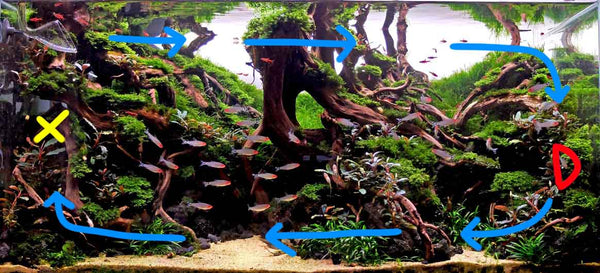
In the tank above, the lily pipe performs two functions well – firstly, it creates water exchange between the surface layer and deeper layers in the tank (an off-gassing mechanism). Secondly, it presses CO2 mist down against the plants where it can be utilized.
Read here about water parameters, GH, PH and KH.
Source www.2hoursaquarist.com, John Tullock, Jeff Miotke
